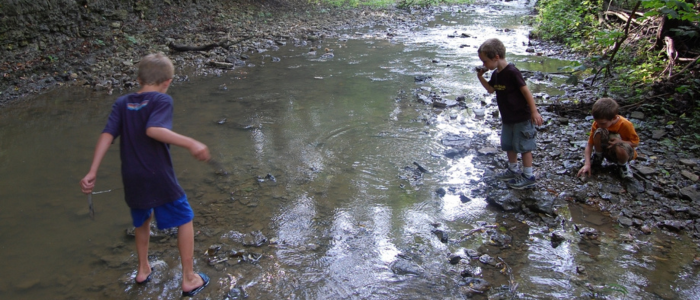
By Alison Mitchell
Executive director, New Jersey Conservation Foundation
Looking to beat the summer heat?
How about splashing around in creeks hunting for fossils? Fossiling is a hands-on, watery adventure perfect for friends and families looking to explore nature, get a little messy and discover ancient treasures together.
It turns out the state is a hot spot for ancient fossils. With just a sifter, trowel and a sense of curiosity, you can come face to face with its prehistoric past.
“Even though we’re a small state, we have over a billion years of rocks preserved at or near the surface,” said Dr. Dana Ehret, curator of natural history at the New Jersey State Museum and a paleontologist specializing in marine biology.
The southern part of the state is a real fossil hot spot because it was once covered by shallow seas. As sea levels rose and fell over millions of years, layers of sediment built up – perfect conditions for preserving fossils. Today, creeks like Big Brook in Monmouth County run through these ancient layers, exposing fossil-rich formations.
While some specimens are embedded in rock, many in New Jersey are preserved in loose, crumbly green sand known as marl. Among the most popular finds are shark teeth.
“Sharks have been around for about 400 million years, and they each shed tens of thousands of teeth in their lifetimes,” Ehret explained. “That’s why shark teeth are the most common vertebrate fossil we find.”
Teeth from extinct species like Otodus obliquus (an ancestor of the legendary Megalodon) are commonly found in the state’s Cretaceous and Eocene layers. And while actual Megalodon teeth are extremely rare here, New Jersey also boasts most of the species that came before it.
But it’s not just teeth. Collectors have found marine reptile bones, fossilized fish, ammonites, sea turtle shells and even trace fossils of long-extinct invertebrates. In some cases, amateur paleontologists and adventurous families have made remarkable contributions to science. Ehret recently displayed a wrist bone from a duck-billed dinosaur at the museum – found by a mother and her child on a casual outing to Big Brook.
“These aren’t rare events,” Ehret said. “People who go regularly and follow the rules have made some truly important discoveries.”
Rules, of course, matter, and visitors should be aware that fossiling is not appropriate or allowed everywhere. Many fossil sites are protected or located near residential areas. Research park system websites or call ahead of time before deciding on a destination, find out about appropriate tools, and take care not to disturb the surrounding environment. Ehret advises not to dig into creek banks, as it accelerates erosion and harms wildlife habitats.
For those eager to learn more, Ehret leads guided fossil-hunting trips where participants are taught how to identify fossils and responsibly collect them. He offers a few tips: Look for symmetry and texture. Real fossils often have mirrored sides or repeating patterns. Teeth typically have glossy enamel and defined roots.
In the late 1830s, a farmer was digging in a marl pit in Haddonfield when he began finding large bones. Further excavation revealed a nearly complete dinosaur skeleton from the Middle Cretaceous Period, the Hadrosaurus foulkii. The discovery was the first complete dinosaur to be found in North America and a bronze sculpture of the Hadrosaurus has long been part of Haddonfield’s downtown.
Beyond the thrill of discovery, fossil hunting opens a window into Earth’s deep history and helps scientists understand the long arc of evolution. Fossils in New Jersey range from 500-million-year-old trilobites to Ice Age mammoths.
“Fossils are for everyone,” Ehret notes. “You never know what you might find.”
To learn more about Big Brook and other fossiling hotspots, visit https://www.monmouthcountyparks.com/. To explore and learn more about New Jersey’s fossils, visit the New Jersey State Museum in Trenton, https://www.nj.gov/state/museum/index.shtml, and the Edelman Fossil Park and Museum in Mantua, https://www.efm.org/.
